Explore fine dining worldwide where artful presentation, regional storytelling, and scenic settings create unforgettable moments. From Michelin-starred restaurants in Chicago, Malta, and Delaware showcasing local ingredients, to coastal venues with breathtaking ocean views and underwater or cave experiences, each place offers immersive environments. Innovative techniques, sustainable sourcing, and thematic menus elevate these adventures. If you keep exploring, you’ll uncover unique venues and extraordinary culinary journeys that turn ordinary meals into memorable events.
Key Takeaways
- Scenic waterfront and natural settings, such as underwater restaurants and cliffside venues, enhance the immersive fine dining experience globally.
- Artistic dishware and thoughtful presentation create storytelling elements that elevate the visual and sensory appeal of meals.
- Regional ingredients and local culinary techniques are incorporated into menus, reflecting cultural heritage and terroir.
- Unique environments like caves, waterfalls, and bamboo treepods provide unforgettable, environmentally integrated dining atmospheres.
- Worldwide trends focus on transforming ordinary spaces into extraordinary, multisensory journeys that captivate all senses.
Artfully Curated Fine Dining in Chicago

Have you ever experienced a meal where art, storytelling, and cuisine seamlessly come together? At Chicago’s Esmé, this happens every time you indulge in their Michelin-starred tasting menu. The restaurant emphasizes storytelling through art-filled dishware, making each course visually compelling and meaningful. The presentation is carefully curated, blending artwork, music, and innovative plating to create an immersive experience. As you savor each bite, you’ll find that the pairing of impressive wine enhances the flavors, elevating the entire journey. Esmé’s quarterly menu updates keep the experience fresh, ensuring no two visits are alike. It’s the perfect place to appreciate how culinary artistry and storytelling can transform a meal into a memorable event, where every detail is designed to delight all your senses. Incorporating artistic dishware further enriches the visual appeal, making the dining experience uniquely captivating. Additionally, thoughtful table settings contribute to the overall ambiance, reinforcing the theme of artistic expression and creating a cohesive dining environment. Paying attention to details in presentation can significantly enhance the overall dining experience, especially considering the importance of visual storytelling in elevating culinary arts, making each visit truly special.
Michelin-Starred Gems in Malta and Delaware

Explore Malta’s Bahia, where local ingredients are transformed into artful dishes inspired by the island’s landscape, highlighting Maltese culinary traditions. In Delaware, Bardea showcases a farm-to-table approach, blending Italian flavors with ingredients sourced from nearby farms to create memorable shared plates. Together, these restaurants exemplify how regional ingredients and storytelling elevate fine dining to an exceptional experience. Incorporating regional ingredients, these establishments demonstrate how a focus on local sourcing enhances culinary storytelling and authenticity.
Maltese Culinary Artistry
What makes Maltese culinary artistry stand out on the global fine dining stage? It’s the way chefs use fresh, local ingredients to craft memorable dishes that tell a story. Bahia, a Michelin-starred restaurant, exemplifies this by organizing its menu around four thematic stages—seed, growth, bloom, and harvest—each reflected through decor and presentation. This approach highlights Malta’s regional topography and agricultural heritage. Guests select a degustation menu using a wooden display that showcases the origin villages, emphasizing provenance and connection to the land. The focus on regional ingredients and storytelling through presentation elevates fine dining into an immersive experience. Malta’s culinary artistry combines tradition with innovation, making each meal a celebration of local flavors and craftsmanship recognized worldwide. Furthermore, the use of regional ingredients in innovative ways demonstrates how Maltese chefs honor their heritage while appealing to modern palates. Incorporating local culinary techniques also plays a vital role in maintaining authenticity while adding a contemporary touch. Additionally, the emphasis on sustainable sourcing reflects a commitment to environmental responsibility and supports local communities.
Delaware Farm-to-Table
Both Malta’s Bahia and Wilmington’s Bardea exemplify the farm-to-table movement by prioritizing fresh, locally sourced ingredients that highlight regional flavors. At Bardea, you enjoy family-style Italian cuisine made with local sourcing from Delaware farms and Italy, emphasizing community and innovation. Bahia draws inspiration from four thematic stages—seed, growth, bloom, harvest—using visual decor to connect diners with Maltese topography and regional ingredients. These restaurants showcase the importance of supporting local agriculture through their commitment to regional ingredients.
| Bardea | Bahia |
|---|---|
| Italian dishes | Maltese regional ingredients |
| Collaborates with local farms | Uses thematic storytelling |
| Emphasizes community | Connects diners with topography |
Coastal Culinary Adventures With Scenic Settings
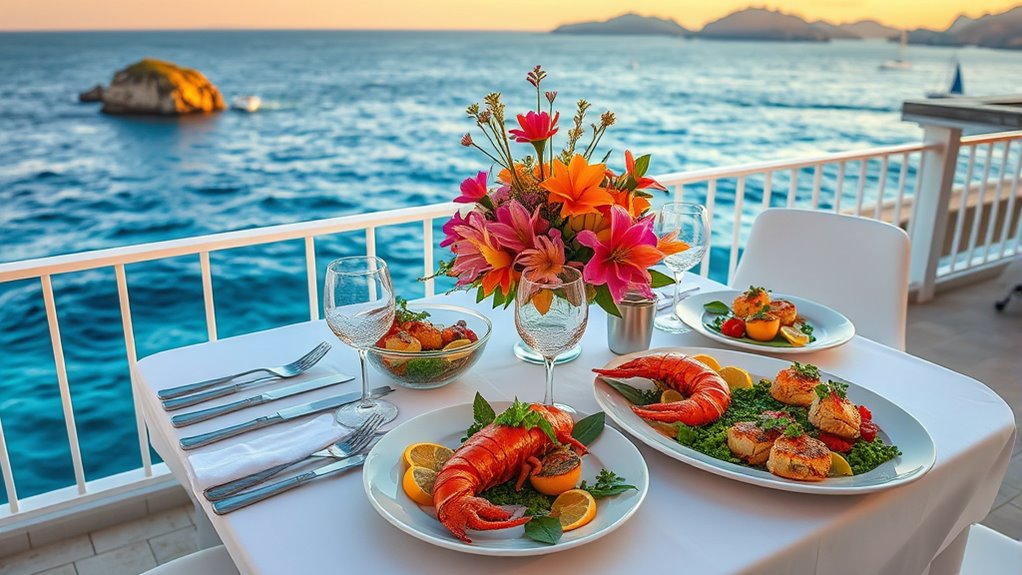
Imagine dining at waterfront destinations where the views of the sea create an unforgettable backdrop for your meal. These unique locations often feature natural settings like cliffs, rocks, or underwater spaces that elevate the experience. With fresh, locally sourced ingredients, your meal becomes a celebration of the coastal environment’s beauty and flavors. Exploring top beach towns on the East Coast can offer a variety of scenic coastal dining options that combine culinary excellence with stunning views. Embracing life’s awkward moments often leads to memorable stories, much like discovering unexpected surprises at these scenic eateries. Many of these coastal spots are accessible with portable camping gear, making it easier to enjoy a comfortable outdoor dining experience amidst nature. Understanding the importance of hydration and nutrition can also enhance your overall enjoyment and health during these coastal adventures.
Waterfront Dining Destinations
Waterfront dining destinations captivate diners by offering breathtaking views of oceans, lakes, or rivers that elevate the culinary experience. These scenic views create a perfect backdrop for enjoying fresh, locally sourced seafood and regional ingredients. Whether you’re dining on a cliffside terrace, aboard a boat, or in an underwater restaurant, the setting immerses you in nature’s beauty. Many venues highlight seasonal or themed menus inspired by their maritime surroundings and culture, making each visit unique. Accessibility varies, from remote islands to urban harbors, offering a range of exclusive experiences. Here’s a glimpse of some iconic waterfront venues:
| Setting | Unique Feature |
|---|---|
| Cliffside terraces | Spectacular panoramic vistas |
| Floating platforms | Exclusive, on-the-water dining |
| Underwater restaurants | Immersive marine environment |
| Seaside docks | Authentic coastal charm |
Additionally, some of these destinations are renowned for their culinary excellence, blending local flavors with innovative techniques to create memorable dining adventures. Incorporating waterfront dining experiences enhances the overall ambiance, making each meal a truly memorable occasion. When selecting a venue, considering accessibility options ensures that all guests can enjoy the scenic setting comfortably and safely. For those seeking optimal comfort and safety, choosing venues with best vacuum ratings ensures a clean and allergen-free environment.
Unique Scenic Locations
Have you ever dined in a setting where the scenery is as breathtaking as the meal? Coastal dining in unique settings transforms ordinary meals into unforgettable experiences. Imagine eating underwater at SEA in the Maldives, where panoramic views of vibrant coral reefs surround you, or enjoying the dramatic cliffs at Grotta Palazzese in Italy, carved into a limestone cave overlooking the sea. Some restaurants, like Tanzania’s Rock, are built on natural formations, accessible only at low tide, offering an exclusive oceanic backdrop. Others incorporate natural elements, such as geothermal grilling at Spain’s El Diablo or water-based dining at the Philippines’ Labassin Waterfall Restaurant. These scenic locations elevate your culinary journey, blending spectacular landscapes with innovative dishes for truly memorable coastal adventures. Incorporating unique dining experiences can create lifelong memories and inspire future travel plans. Additionally, many of these settings support sustainable beekeeping practices, enhancing the local ecosystem and ensuring the preservation of natural beauty. The integration of natural materials in surrounding architecture or decor further enhances the immersive experience, making each meal feel connected to the environment. Moreover, the use of eco-friendly techniques in these establishments helps reduce their environmental impact while maintaining their stunning natural appeal.
Nature-Inspired Culinary Settings
Nature-inspired culinary settings turn scenic locations into immersive dining experiences that connect you directly with the environment. Imagine savoring seafood or tropical fruits amidst breathtaking views of the ocean, cliffs, or waterfalls. These venues often feature dishes made from local ingredients, highlighting regional flavors and techniques, like volcanic grilling or fresh seafood. Unique sites such as underwater restaurants or cliffside bavilons heighten your sensory journey, blending natural beauty with culinary artistry. Accessibility varies, adding an element of adventure and exclusivity to each meal. By choosing these settings, you embrace the harmony of nature and cuisine, turning a meal into an exploration of environment and flavor. Engaging with local ingredients can deepen your appreciation for regional culinary traditions. Selecting the right setting can also enhance your appreciation for environmental harmony, creating a memorable dining experience.
Unique Environments and Scenic Dining Locations

Many dining experiences stand out because of their extraordinary settings, allowing you to immerse yourself in striking natural or architectural surroundings. Scenic dining in these unique environments offers immersive experiences that go beyond just the meal. Imagine eating inside a limestone cave in Greece or at a waterfall-side restaurant in the Philippines, where nature’s beauty surrounds you. Some venues, like an underwater restaurant in the Maldives or a bamboo treepod in Thailand, put you directly in the midst of nature, heightening your senses. Iconic spots include a rock in the Indian Ocean accessible only at low tide or a cave with open ceilings for star gazing. Many of these locations emphasize blending natural beauty with culinary delight, creating unforgettable scenic dining adventures. Navigating the evolving landscape of unique dining experiences continues to inspire travelers seeking extraordinary environments, highlighting the importance of environmental integration in modern gastronomy. Additionally, the rise of sustainable design in venue construction enhances these extraordinary experiences by reducing environmental impact and harmonizing with natural surroundings.
Innovative Cooking Techniques and Menus Around the World
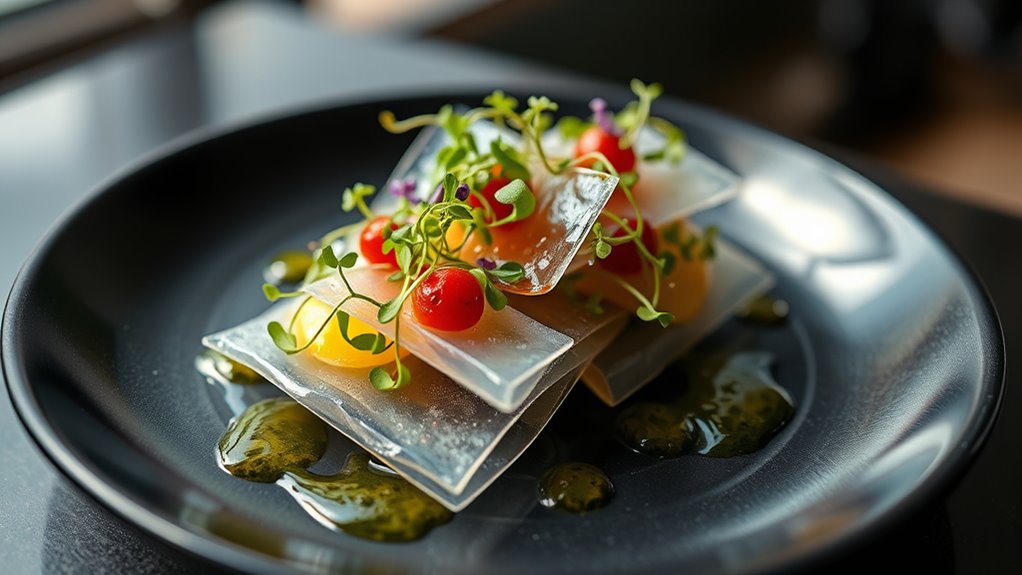
Innovative cooking techniques are transforming the way diners experience cuisine around the world. Chefs are pushing boundaries with techniques like volcanic grilling in Spain’s El Diablo, where food is cooked on geothermal heat at 752°F, creating bold flavors. Theatrical methods, such as tableside flambe and ice balloon presentations, add excitement and interactivity to meals. Fusion menus, like Aspen’s Matsuhisa, blend Japanese and Peruvian traditions, resulting in inventive flavor combinations. Underwater dining experiences, exemplified by Maldives’ SEA, immerse guests in marine environments while serving fresh, marine-inspired dishes. Many restaurants emphasize seasonal and locally sourced ingredients, constantly refining their menus to reflect regional harvests. These innovative techniques and menus elevate fine dining, offering memorable, dynamic experiences around the globe.
Hidden Culinary Treasures in Remote Regions
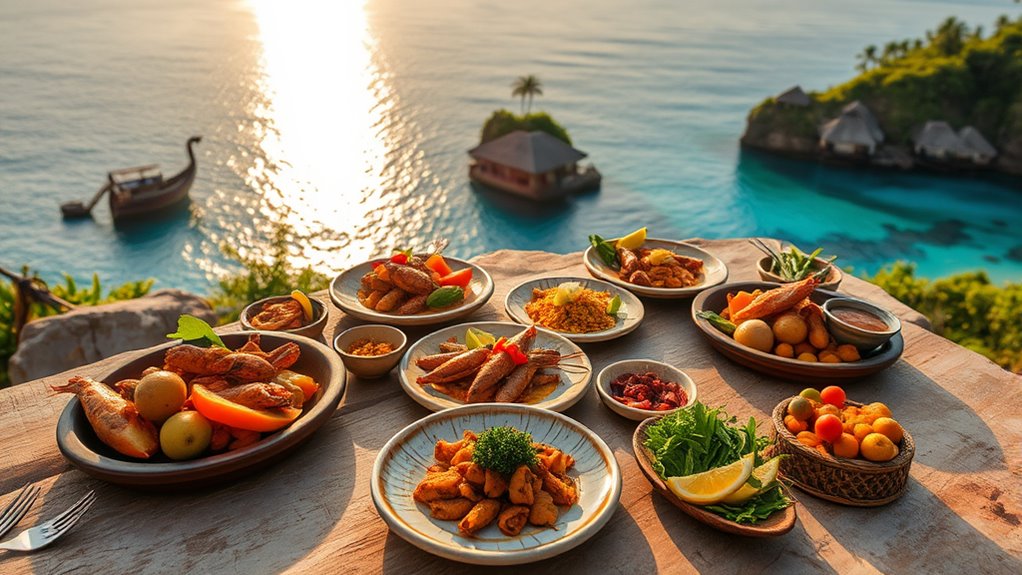
Hidden culinary treasures often lie in the most remote regions, where extraordinary locations elevate dining into unforgettable adventures. These hidden gems showcase the magic of remote regions, offering unique dining experiences that blend nature and cuisine. Imagine savoring meals at the Labassin Waterfall Restaurant in the Philippines, surrounded by natural waterfalls, or visiting The Rock restaurant in Tanzania, perched on a solitary rock in the Indian Ocean.
Discover remote dining wonders like waterfalls and solitary rocks for unforgettable culinary adventures.
Consider these key points:
- Many hidden culinary treasures emphasize local ingredients and environmental harmony.
- Access often requires adventurous travel, like low tide walks or boat rides.
- Unique dining settings transform meals into immersive experiences.
- Innovative use of location, such as geothermal cooking or rainforest treetop dining, highlights creativity in remote regions.
These hidden gems deliver exclusive, memorable food experiences far from bustling cities.
Art, Storytelling, and Local Sourcing in Modern Cuisine
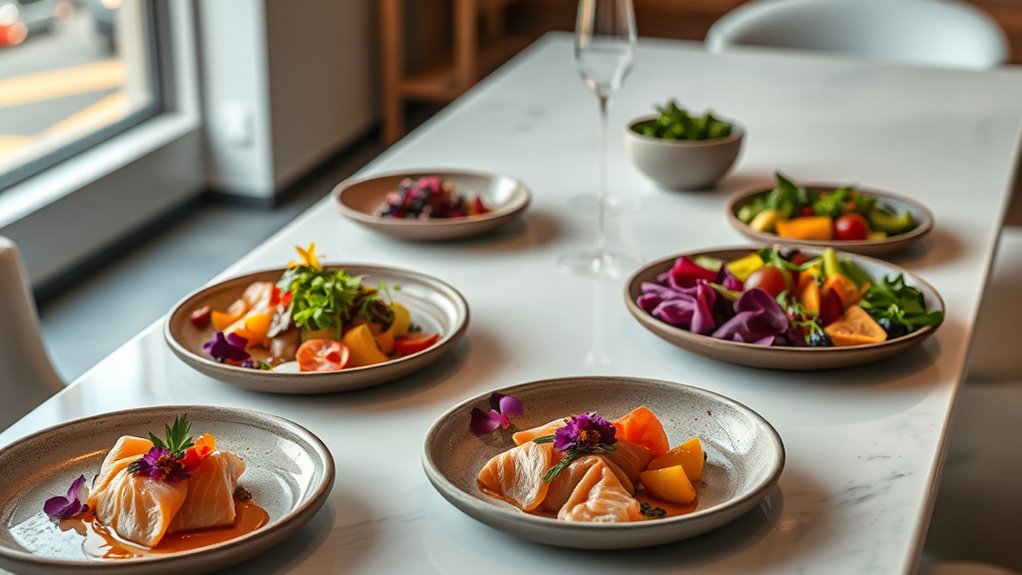
Modern cuisine elevates dining into an immersive storytelling experience by integrating art, cultural themes, and local sourcing. You’ll notice how chefs use artful plating, themed decor, and artwork to convey stories and regional histories, like Bahia’s depictions of Maltese villages or Esmé’s art collaborations. Emphasizing local sourcing, chefs partner with regional farmers and artisans to ensure fresh, seasonal ingredients that deepen the narrative of their dishes. This focus not only supports community sustainability but also highlights the region’s unique flavors and traditions. By incorporating local topography and cultural elements into presentation, restaurants create a connection between diners and the environment. Ultimately, art and storytelling serve as powerful tools to transform a meal into a meaningful, expressive journey through regional identity.
Memorable Dining Experiences in Unusual Venues
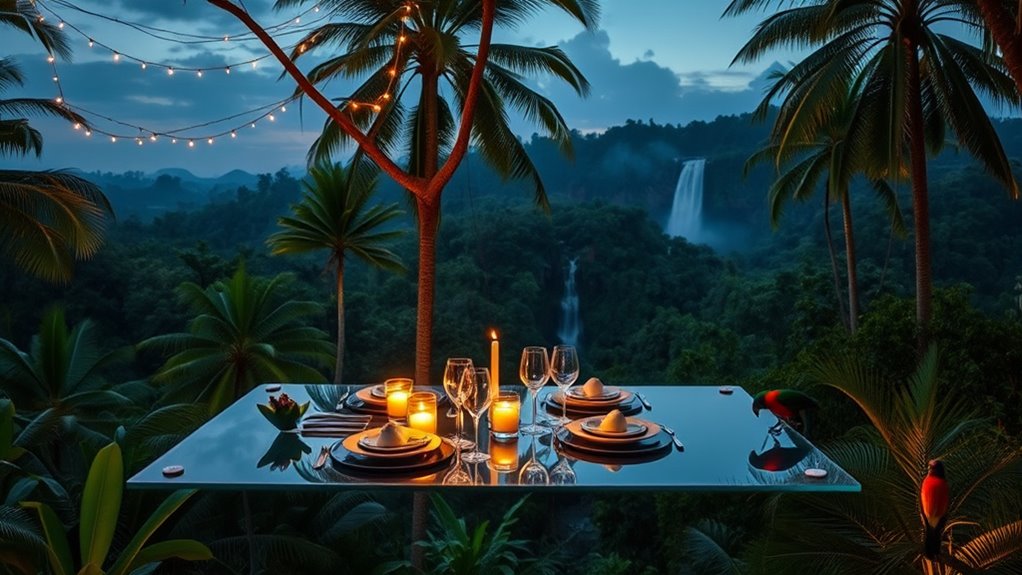
Dining in unusual venues transforms a meal into an unforgettable adventure by immersing you in stunning natural or historic surroundings. These immersive dining experiences blend scenic beauty with culinary excellence, leaving lasting memories. Some standout examples include:
Dining in unique settings turns meals into memorable adventures surrounded by breathtaking natural or historic beauty.
- Underwater restaurants like SEA in the Maldives, where you enjoy marine-inspired dishes with views of coral reefs.
- Cave dining, offering a mysterious ambiance and natural acoustics that elevate your meal.
- Geothermal-powered restaurants such as El Diablo in Spain, where volcanic heat cooks your food naturally.
- Treepod Dining in Thailand, suspending you above the rainforest in bamboo nests for a unique adventure.
Unusual venues turn ordinary dining into extraordinary moments, making scenic beauty and immersive experiences the highlights of your culinary journey.
Frequently Asked Questions
Which Country Has the Best Fine Dining?
You’re wondering which country offers the best fine dining. While it’s hard to pick just one, France often stands out with its legendary haute cuisine and numerous Michelin-starred restaurants. Japan’s precision and innovation impress, especially in Tokyo. Italy’s rich regional flavors and elegant settings also make it a top choice. Ultimately, your experience depends on your tastes, but each country offers exceptional, unforgettable culinary adventures.
What Is the Most Expensive Dining Experience in the World?
You’re curious about the most expensive dining experience in the world. It’s Sublimotion in Ibiza, Spain, where you pay around $2,000 per person for a multi-sensory meal. This exclusive experience combines innovative cuisine, immersive entertainment, and a stunning setting. Its high price reflects the advanced technology, talented chefs, and unique environment, offering you a once-in-a-lifetime adventure that goes far beyond just a meal.
Why Are Fine Dining Restaurants Closing?
You might notice that many fine dining restaurants are closing because rising costs make it hard to stay profitable. High rent, staffing, and ingredients eat into profits, especially after the COVID-19 pandemic reduced customers. Competition from casual and fast-food options, along with supply chain issues and changing customer preferences for more relaxed or health-focused dining, also contribute to their decline. These factors make it tough for traditional fine dining to survive.
What Is Considered Fine Dining Experience?
Imagine stepping into a world where every detail whispers luxury—this is a fine dining experience. You’re treated to high-quality ingredients, artfully presented dishes, and impeccable service that feels like a warm embrace. The elegant ambiance, from lighting to decor, sets the perfect scene. It’s a multi-sensory journey, often in scenic locations, where you dress up, relax, and indulge in memorable moments crafted just for you.
Conclusion
No matter where you dine around the world, each experience promises to be unforgettable, like tasting a slice of heaven on earth. From hidden gems to scenic settings, every meal tells a story and sparks your senses. So go ahead, seek out those extraordinary spots—your taste buds will thank you, and you’ll feel like you’ve discovered culinary magic that’s truly beyond compare. Get ready to turn every meal into a legendary adventure!










